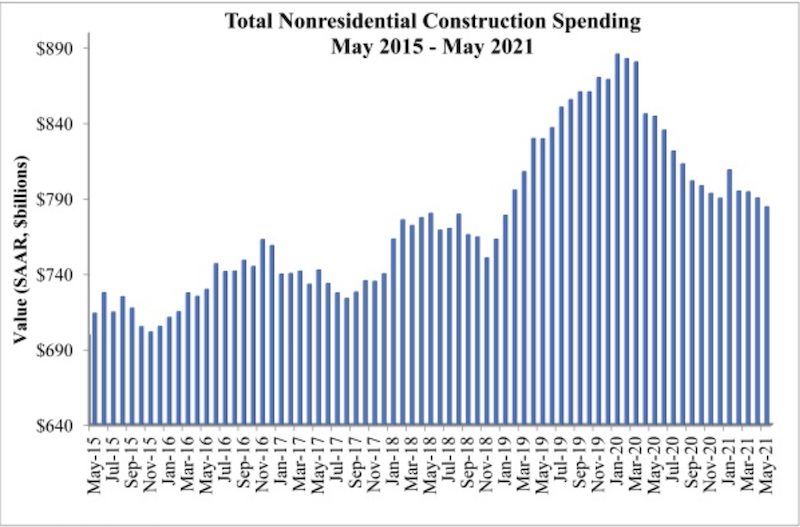In its first-quarter index of Construction Confidence, the Associated Builders and Contractors (ABC) found that 55% of contractors expected their sales to increase over the following six months, and only 19% thought their sales would decline in that period.
They might need to recalibrate their exuberance, in light of the trade group’s latest analysis of data published by the U.S. Census Bureau, which ABC released today. It estimates that national nonresidential construction spending in May, at $784.5 billion, was down 7.1% from the same month a year ago, and off 0.7% from spending levels in April 2021.
On a year-over-year basis, spending for every nonresidential category that ABC tracks, except sewage and waste disposal, was negative. Spending on public safety projects—which surged during the early months of the pandemic—showed the greatest decline in May, 39.6%, and lodging also took a big hit (off 23.3% to $22.6 billion). On the other hand, spending in May on healthcare construction, nearly $47 billion, was down only marginally, by 1.5%, compared to the same month a year ago.
WORKER SHORTAGES AND MATERIAL PRICING REMAIN PROJECT ROADBLOCKS

Construction spending for public safety and lodging projects showed the steepest declines in May compared to the same month a year ago.
A red-hot data center market hasn’t spelled more office construction, notes Anirban Basu, ABC’s Chief Economist. Basu also points out that while some private construction segments are struggling under the dislocating impacts of the pandemic, public nonresidential construction actually has declined more rapidly than the private sector over the past year.
Basu sees some hope for the future. Public construction spending should benefit from improvements in state and local governments’ financial conditions. But he tempers his predictions because of still-high construction materials prices and “deeply problematic” worker shortages. Basu expressed some concern, too, about the disproportionate amount of spending moving toward residential construction, which accounted for 41% of the pre-pandemic total and 49% in May.
Related Stories
| Dec 17, 2010
Cladding Do’s and Don’ts
A veteran structural engineer offers expert advice on how to avoid problems with stone cladding and glass/aluminum cladding systems.
| Dec 17, 2010
5 Tips on Building with SIPs
Structural insulated panels are gaining the attention of Building Teams interested in achieving high-performance building envelopes in commercial, industrial, and institutional projects.
| Dec 17, 2010
How to Win More University Projects
University architects representing four prominent institutions of higher learning tell how your firm can get the inside track on major projects.
| Dec 13, 2010
Energy efficiency No. 1 priority for commercial office tenants
Green building initiatives are a key influencer when tenants decide to sign a commercial real estate lease, according to a survey by GE Capital Real Estate. The survey, which was conducted over the past year and included more than 2,220 office tenants in the U.S., Canada, France, Germany, Sweden, the UK, Spain, and Japan, shows that energy efficiency remains the No. 1 priority in most countries. Also ranking near the top: waste reduction programs and indoor air.
| Dec 7, 2010
Are green building RFPs more important than contracts?
The Request for Proposal (RFP) process is key to managing a successful LEED project, according to Green Building Law Update. While most people think a contract is the key element to a successful construction project, successfully managing a LEED project requires a clear RFP that addresses many of the problems that can lead to litigation.
| Dec 7, 2010
Blue is the future of green design
Blue design creates places that are not just neutral, but actually add back to the world and is the future of sustainable design and architecture, according to an interview with Paul Eagle, managing director of Perkins+Will, New York; and Janice Barnes, principal at the firm and global discipline leader for planning and strategies.
| Dec 7, 2010
Green building thrives in shaky economy
Green building’s momentum hasn’t been stopped by the economic recession and will keep speeding through the recovery, while at the same time building owners are looking to go green more for economic reasons than environmental ones. Green building has grown 50% in the past two years; total construction starts have shrunk 26% over the same time period, according to “Green Outlook 2011” report. The green-building sector is expected to nearly triple by 2015, representing as much as $145 billion in new construction activity.
| Dec 7, 2010
USGBC: Wood-certification benchmarks fail to pass
The proposed Forest Certification Benchmark to determine when wood-certification groups would have their certification qualify for points in the LEED rating systemdid not pass the USGBC member ballot. As a result, the Certified Wood credit in LEED will remain as it is currently written. To date, only wood certified by the Forest Stewardship Council qualifies for a point in the LEED, while other organizations, such as the Sustainable Forestry Initiative, the Canadian Standards Association, and the American Tree Farm System, are excluded.
| Dec 7, 2010
AGC of A Survey: 2011 Construction Industry Hiring and Business Outlook
The Associated General Contractors of America wants to know about your construction company’s business outlook for 2011. Help out the Association by answering a few quick questions in their 2011 Construction Industry Hiring and Business Outlook survey.











